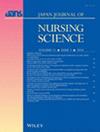Modification of the association between nausea and vomiting of pregnancy and anxiety by personality trait during early pregnancy: A longitudinal study of Japanese pregnant women
Abstract
Aim
This study aimed to elucidate whether personality traits modify the relationship between nausea and vomiting of pregnancy (NVP) and anxiety, stratified by three pregnancy periods: 5–8 weeks, 9–12 weeks, and 13–20 weeks.
Methods
This longitudinal study was conducted from August 2018 to February 2019 at a perinatal outpatient unit in a general hospital. We included 153 pregnant women aged ≥20 years and under 20 weeks of gestation at their first prenatal visit. They completed the Index of Nausea, Vomiting, and Retching, and the State–Trait Anxiety Inventory (STAI) to measure anxiety in terms of both trait (STAI-T) and state anxiety (STAI-S), and retook them at follow-up checkups for a maximum of three times.
Results
Using longitudinal data until 20 weeks' gestation, changes in NVP and trait anxiety were significantly associated with changes in state anxiety independently, with trait anxiety being more strongly involved than the change in NVP. This tendency was pronounced in the high-trait anxiety group with STAI-T scores of ≥45. Cross-sectional analyses by gestational week showed similar results in the low-trait anxiety group (STAI-T < 45). In the high-trait anxiety group, only trait anxiety was significantly associated with state anxiety up to 12 weeks gestation. However, only NVP was significantly associated with state anxiety after 13 weeks.
Conclusions
Pregnant women who tend to be anxious temperamentally may have other factors that cause anxiety besides nausea immediately after the discovery of pregnancy. Understanding personality traits may help reduce anxiety in pregnant women.

 求助内容:
求助内容: 应助结果提醒方式:
应助结果提醒方式:


